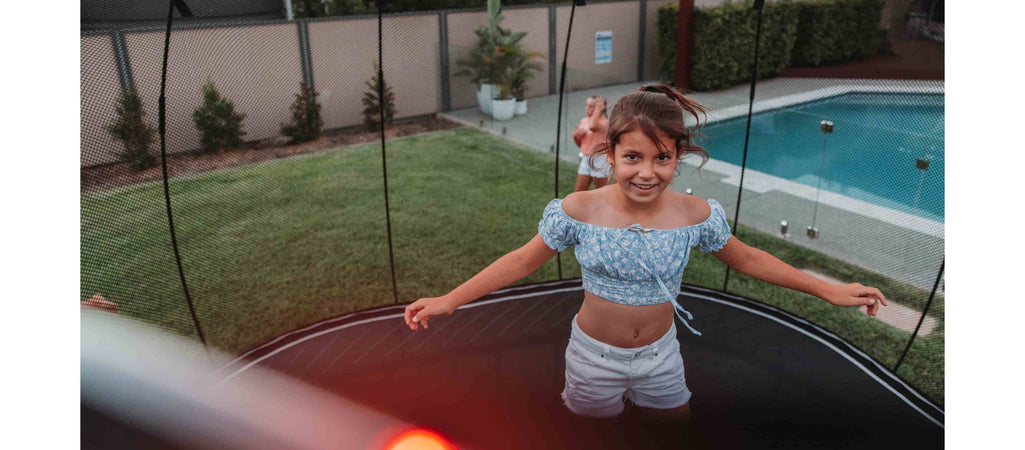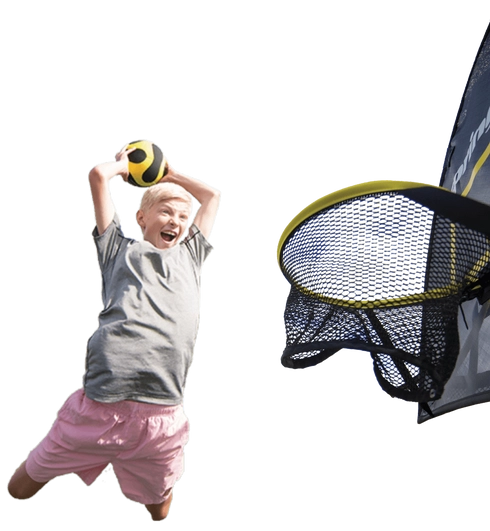How to Choose the Right Outdoor Trampoline for Kids | Expert Guide
Keep your kids safe and entertained with the right outdoor trampoline. Learn key considerations and see the best trampolines for kids by age!
min read

If you’re looking for an outdoor trampoline for kids, you’re going to want to read this.
Yes, trampolines can be dangerous if you buy a low-quality model or use it improperly. But we’re going to use our trampoline expertise to make sure your kids are safe and joyful when jumping.
This article will cover everything you need to know about getting a fun and safe outdoor trampoline for your little ones.
5 Essential Considerations for Buying an Outdoor Trampoline
Below are the five questions you must answer before you can confidently say, “This is the right outdoor trampoline for my kids!”
1. What Type of Trampoline Do You Want?
First things first, you’ve got to find the right type of trampoline for your bounce. Here are your three options:
- Backyard Spring Trampolines - Known for their classic design, spring trampolines rely on metal springs to create the bounce. This traditional trampoline style has been a staple in backyards since the mid-20th century. You may have had one as a child!

Photo courtesy of Wayfair.
- Backyard Springless Trampolines – This innovative trampoline type, first introduced in the early 2000s, is engineered with safety in mind. They eliminate the metal springs and replace them with safer alternatives, like composite rods or elastic bands.

Springfree Trampoline.
- Inground Trampolines - Inground trampolines are trampolines that are installed at ground level, typically by digging a hole similar to installing a swimming pool. They are often chosen for their reduced height and improved integration into the surrounding landscape.

Photo courtesy of Trampolines.com.
It’s important to note that the first two trampoline types, installed above the ground, are much more common in backyards. The cost of inground trampoline installation can run up to $5,000+ and they are difficult to move once installed.
2. What Size of Trampoline Do You Need?
Pay extra attention to this one! The size of a trampoline might be the most crucial factor to consider before buying a trampoline for kids. Let’s break it down into sections, detailing all the elements of a trampoline’s size:
Backyard Space
The first step to choosing the right trampoline is accurately measuring your yard. Ensure a safe and suitable location by following these steps:
Step #1: Find a clear, level area with minimal slopes (less than three degrees).
Step #2: Measure the length and width of your chosen spot.
Step #3: Allow 3-5 feet of safe lateral clearance around the trampoline.

Jumpers’ Age and Future Growth
Consider the age and anticipated growth of your children. It's advisable to adopt a "grow into" mindset rather than a "grow out of" one.
For example, if you have a nine-year-old and foresee long-term trampoline use, a large outdoor trampoline (if space allows) is a wise choice. This not only maximizes your investment but can provide years of enjoyment, even through high school!
Trampoline Weight Limit
Trampoline weight limits must be carefully considered. Going beyond these limits can result in injury, such as falling through the trampoline.
There are two key weight limits to keep in mind: the total static weight limit and the individual jumper weight limit.
It's essential to consider both when selecting a trampoline. Keep in mind that weight limits can differ between trampoline brands, so thorough research is necessary to find one that suits your kid(s) weight. If you have growing children, plan ahead!
Jumping Room
The amount of jumping space is way more important than you think. Here's a little-known secret: many trampoline manufacturers mislead you about the jumping space on their trampolines.
Take a close look at the trampoline with springs below (courtesy of Wayfair) and we’ll explain:

This is branded as a 15 ft trampoline. But look closely: Do you notice how the safety padding around the net, covering the springs, takes up nearly two feet of jumping space?
So, it’s not really a 15 ft trampoline in terms of jumping space. It’s more like a 13 ft trampoline.
Springless trampolines don’t have this problem because they don’t have springs. They have a smaller overall footprint but still provide more space to jump. Keep this in mind, particularly if your child wants to be the next Simone Biles and needs plenty of room to jump!
Trampoline Shape
When considering a trampoline's size, don't overlook the significance of its shape. Here are the main trampoline shapes:
- Round Trampolines – Traditional trampoline shape that is suitable for young children and recreational use.
- Oval Trampolines - Great for recreational use and narrow backyards.
- Rectangle Trampolines - Ideal for those needing ample space, especially for gymnastics or athletic activities.
- Square Trampolines - A unique shape, perfect for jumpers who require plenty of room.
Fact: Rectangle and square trampolines maximize the jumping surface because they fill in the corners that an oval or round trampoline cuts out.
3. What Trampoline Safety/Quality Features Are Required?
Now, it’s time to dive into another critical aspect of buying a trampoline, the safety and quality features. Here’s what to look for when shopping for a safe and quality trampoline:
- An enclosure net designed for flexibility and crafted from durable, UV-resistant materials. (Never buy an outdoor trampoline without a net!)
- No springs or quality safety padding over the springs (you also want to see the springs outside of the mat area).
- The use of enclosure rods or non-static poles that are padded.
- A shock-absorbent trampoline mat featuring soft edges for added protection.
- A galvanized trampoline frame that is padded or hidden.
- The use of weather-resistant, rust-resistant and UV-protected materials.
- A long trampoline warranty (5-10+ years)
- Meets ASTM Trampoline Standards
- A full-service support program (warranty support, spare parts, maintenance advice, relocation services) should anything arise after purchase.
Example of Springfree Trampoline’s safety features:

4. How Long Do You Want the Trampoline to Last?
Now, you must figure out how long you want your trampoline to last. See the estimated time ranges below so you get a feel for how long trampolines last:
- Cheap trampolines: 1-3 years
- Average trampolines: 3-8 years
- High-quality trampolines: 5-10+years
- Above-ground trampolines: 1-10+ years
- Inground trampolines (trampolines installed in the ground): 5-10+ years
For long-term use, investing in a high-quality trampoline is worth it. It ensures safety, peace of mind, and minimal maintenance for years of jumping.
Again, consider the “grow into, not out of” mindset for your little ones. They won’t stay little forever, and you don’t want to buy another trampoline because they outgrew the old one.
5. How Much Are You Willing to Spend?
Once you’ve considered all the factors above, it’s time to set a budget. First, let’s go over how much trampolines cost:
- Above-ground traditional, spring-based trampolines: $200-2,500+
- Above-ground springless trampolines - $800-$4,000+
- Inground Trampolines - $1000-$5,000+
Cheap trampolines ($200-$300) come with multiple safety risks and usually won’t last 1-3 years without needing maintenance. If you’re buying a budget trampoline, MAKE SURE it comes with some of the essential safety features.
Our advice is to explore trampoline financing and be strategic with your shopping. Look for trampolines on sale around Black Friday, Cyber Monday or early spring to get a premium trampoline for a better price.
Other Outdoor Trampoline Considerations
The five factors above are what you can think of as the “core” trampoline considerations. The following are the “others.” These are important but shouldn’t be the deciding factor in your trampoline purchase:
- Trampoline accessories and upgrades, like a trampoline basketball hoop or ladder.
- Trampoline installation and maintenance – how difficult is the installation process and how much maintenance will be required?
- Where to buy a trampoline (retailer, directly from the brand, dealer, etc.)
- How to buy a trampoline (online vs. in-store).
After considering these other factors, you have successfully evaluated all the factors to buying an outdoor trampoline for your kids. Now, which trampoline should you buy?
Which Are the Best Trampolines for Kids?
We previously made an objective and honest list of the best trampolines for kids (check it out for details on each trampoline) broken down by age range.
Below are the eight trampolines we chose as the best ones for kids this year:
Best Trampolines for 6-8 Year Old’s
- Springfree Mini-Round Trampoline ($799)
- Skywalker 8 ft Trampoline ($199)

Photo courtesy of Skywalker.
Best Trampolines for 6-12 Year Old’s
- Springfree Medium Oval Trampoline ($1,599)
- Acon Air 10 ft Trampoline ($749)
Best Trampolines for 10-16 Year Old’s
- Springfree Large Square Trampoline ($1,999)
- Jumpflex 12 ft Trampoline ($849)
Best Trampolines for 12-18 Year Old’s
- Springfree Jumbo Square Trampoline ($2,499)
- JumpSport AlleyOOP 14 ft Trampoline ($1,899)

Springfree Jumbo Square Trampoline.
This is just one expert’s opinion and it’s possible you may have a different one. But this list should at least give you a head start on where to look for your kids’ trampoline!
FAQ: Outdoor Trampolines for Kids
We’re almost there: Let’s close this out with some frequently asked questions about buying an outdoor trampoline for your kid(s):
1. Are Outdoor Trampolines Safe for Kids?
Yes! Assuming you buy a quality trampoline and follow basic trampoline safety rules, outdoor trampolines are safe for kids.
2. What Is the Best/Safest Trampoline for Kids?
Springfree Trampoline, with its industry-leading safety and quality features, ranks at the top as the best trampoline for kids. However, there are multiple other options if you can’t justify paying top dollar for a Springfree and just want a good-quality trampoline.
3. Should I Get My 5-Year-Old a Trampoline?
NO! Do not buy any child under the age of six an outdoor trampoline. If you want a trampoline for a child five or younger, consider buying a toddler trampoline (like a Little Tikes Trampoline).
4. Why Are Trampolines Not Recommended for Under 6?
The American Academy of Pediatrics recommends that no child under age six jump on a trampoline. This is because the bones of young children are still undeveloped and may be more prone to fractures.
Visualize Your Outdoor Trampoline in Your Yard Before Buying
There it is – you now know what to look for when buying a trampoline for your kids. To recap:
- All the considerations when buying an outdoor trampoline for kids.
- The eight best trampoline models to buy for kids this year.
- Answers to common questions about outdoor trampolines for kids.
Your next step? Check out our free AR Tool to virtually place a trampoline in your yard to see if it will fit. You can do it in three easy steps:
1. Visit Springfree Trampoline's website on your phone.
2. Select a trampoline and tap the AR icon.
3. Use your phone to view, adjust, and screenshot the trampoline in your yard.
Choose different trampoline sizes and shapes to test out which trampoline fits best in your backyard. Happy shopping!


